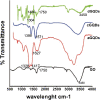Cellular distribution and cytotoxicity of graphene quantum dots with different functional groups
- PMID: 24597852
- PMCID: PMC3973856
- DOI: 10.1186/1556-276X-9-108
Cellular distribution and cytotoxicity of graphene quantum dots with different functional groups
Abstract
Graphene quantum dots (GQDs) have been developed as promising optical probes for bioimaging due to their excellent photoluminescent properties. Additionally, the fluorescence spectrum and quantum yield of GQDs are highly dependent on the surface functional groups on the carbon sheets. However, the distribution and cytotoxicity of GQDs functionalized with different chemical groups have not been specifically investigated. Herein, the cytotoxicity of three kinds of GQDs with different modified groups (NH2, COOH, and CO-N (CH3)2, respectively) in human A549 lung carcinoma cells and human neural glioma C6 cells was investigated using thiazoyl blue colorimetric (MTT) assay and trypan blue assay. The cellular apoptosis or necrosis was then evaluated by flow cytometry analysis. It was demonstrated that the three modified GQDs showed good biocompatibility even when the concentration reached 200 μg/mL. The Raman spectra of cells treated with GQDs with different functional groups also showed no distinct changes, affording molecular level evidence for the biocompatibility of the three kinds of GQDs. The cellular distribution of the three modified GQDs was observed using a fluorescence microscope. The data revealed that GQDs randomly dispersed in the cytoplasm but not diffused into nucleus. Therefore, GQDs with different functional groups have low cytotoxicity and excellent biocompatibility regardless of chemical modification, offering good prospects for bioimaging and other biomedical applications.
Figures








References
LinkOut - more resources
Full Text Sources
Other Literature Sources

